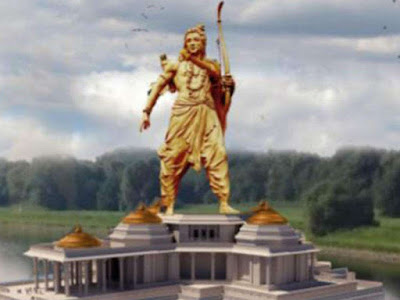“if Ram Rajya comes, we will
completely ban the Urdu language,” says
the BJP’s Telangana state chief B S Kumar. Only Urdu? That was the first
question which arose in my mind. Kumar’s party has been demolishing mosques and
churches in order to construct temples for Lord Rama. It has been killing
people who are supposedly enemies of Lord Rama. Some people were lucky to escape
death by the skin of their teeth. People’s dresses, food, languages, cultures,
and so on are being assaulted for the sake of Lord Rama.
Anyone who
knows Rama will also know that the Lord must be wondering how some people who
claim to be his fans or devotees have come to imagine him as such a
bloodthirsty monster. He must be longing to run away along with the hundreds
of thousands of Indians who have chosen to leave India permanently and
settle down in better countries.
In April
2014, a month before Modi became India’s Prime Minister, I wrote a story titled
Sarayu’s
Sorrow. Lord Rama sits on the bank of the Sarayu with a heavy heart.
Sita had left him, having refused to undergo yet another fire test. “How many
fire tests will be required before my husband can trust my fidelity?” Sita
asked.
Rama was torn
between the need to please his subjects and the need to hold Sita close to his
heart. “People don’t like to see others living in love,” Rama thinks. “They
like strife and dissidence…. They want war when they are bored with the mundane
affairs.”
What did King
Rama want? Love or political power?
Why did Rama
choose to abandon Sita for the sake of power?
Valmiki
visits Rama the morning after Sita is taken away by the earth forever from a
man whose heart wavers between love for her and love of power. “Your sons are
with me,” Valmiki tells Rama. “They should be growing up in the palace…. Or do
you wish to bestow on them your guilt?”
Rama wonders
what he can bestow on anyone except his guilt.
Are we still
living with that guilt? Are we the inheritors of Rama’s guilt?
***

Proposed statue of Rama in Ayodhya
Yogi Adityanath will be installing
the tallest statue of Lord Rama (251 metres) in Ayodhya sooner than later. Lord
Rama with a bow and a quiver of arrows. A symbol of aggression and violence.
What a god!
Hari OM
ReplyDeleteAgain you highlight the fact that those who are shouting loudast 'Sri Ram Sri Ram' are likely to be the least shining examples of true devotees. Zealots are rarely sensible.
Like so many fundamentalists, the aspect of warrior is used and the philosophical metaphors are lost to them. As Krishna's chariot is representative of our physical being with all the senses running like horses, to be reined in and directed by our intellectual selves, so Rama's bow is the mind and arrow is our intellect. How skilled we are with those is how well we can 'hit our target'. Those who lust for power fail/refuse/are incapable of appreciating the allegorical nature of the text they claim as their guide.
Rama was not power-hungry; he was faced with an ethical dilemma. Whereas a moral dilemma confronts us with two choices, one moral and the other immoral, an ethical dilemma presents two choices, both moral. For resolving an ethical dilemma, we need to discern the higher moral principle and harmonize the lower moral principle as much as possible. Rama’s dilemma was ethical because his duty as a king conflicted with his duty as a husband.
From here, I see only moral and immoral issues in India now - rarely do ethics come into the actions about which we read... YAM xx
Thanks, Yamini, for the spiritual interpretation of the apparently violent postures of our deities. My story looks at the Maryadha Purushottam's character from another literarily possible angle. After all, Rama could not have been apathetic to what happened to Sita in the end. If i were in his shoes, i wouldn't throw my wife to silly people's desires....
DeleteI often wonder what these polictians have before speaking such ludicrous things. Does't he know that urdu and hindi are more or less the same language. The grammar is same and so is most of the vocabulary. It's just the script that separates them and that's because of politically motivated reason. I too agree that people who are shouting lord rama the loudest are the ones who have not yet understood him. He was the one who denounced the kingdom. He was the one who had sent his emissaries to Lanka to Ravana and asked him to give back his wife. He only fought because he was forced to not because he liked power. But now a days these people are just using his name to spread their hate. I don't believe in God but if there is any than i wonder what he would be thinking right now. Would he be sad or just exasperated?
ReplyDeleteUrdu is far superior to Hindi in literature as well as culture. But we live in a time which is out of joint, thanks to our political leaders.
DeleteI have never been able to come to terms with Ram's rejection of Sita in the end. What kind of love is that?
I did'nt know this about this. Thanks for sharing.
ReplyDeleteWelcome.
Delete